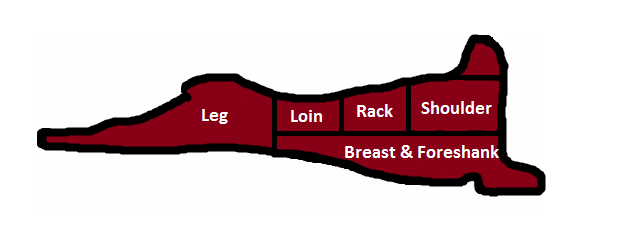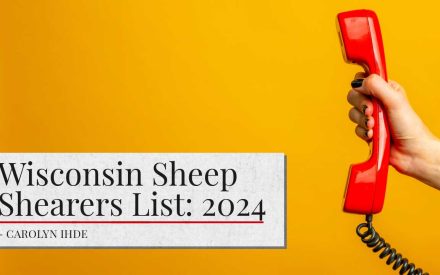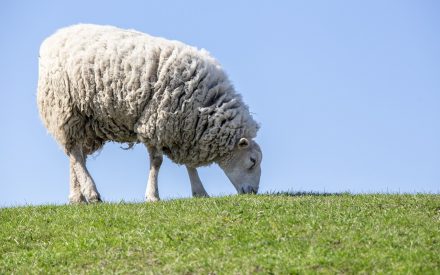Dressing Percentage
To better understand the amount of edible product expected from a grain finished lamb, the first step is understanding the difference in live weight compared to carcass weight. When a lamb (male or female sheep under one year of age) is harvested, certain parts of the animal such as the pelt (hide and wool), feet, blood, and viscera (internal organs) are removed. The post-harvest hanging weight, known as the hot carcass weight, includes the lean (meat), adipose tissue (fat), and bone. Dressing percentage is the difference between live animal and carcass weight and is influenced by factors such as muscle, fat cover and size, to name a few. These factors help determine how much meat the carcass may yield (Table 1).
Table 1. Dressing Percentage Factors
| Factor | Dressing Percent (%) |
| Conventional fed | 44 – 56 |
| Shorn lambs | Average 54 |
| Unshorn lambs | Average 52 |
| More finish | higher |
| Grass fed | lower |
| Heavier muscled | higher |
Carcass Fabrication
During carcass chilling and fabrication, some carcass weight will be lost from the hanging, boning and trimming. The percentage of carcass weight remaining is the “take-home” or retail meat cuts and is called the carcass cutting yield.
Carcass cutting yield is variable and depends on the carcass’s fat thickness (leaner carcasses have increased yields), muscling (greater muscling increases yield), and the amount of bone-in versus boneless retail cuts (boneless decreases yield). (Table 2).
Table 2. Average Carcass Cutting Yield
| Cut Type | Cutting Yield |
| Boneless closely trimmed retail cuts | 43 -50% |
| Bone-in regularly trimmed retail cuts | 65 – 75% |
Requesting closely trimmed and boneless steaks and roasts and/or trimmed, lean ground lamb will result in less pounds of take-home product. This may be advantageous depending on available freezer space and eating preferences. It is important to understand that the amount of edible lean will be the same regardless if the retail cuts are boneless or bone-in. The primary difference will be the inclusion of bone and sometimes some additional fat removal. Choosing to bring home organ meats such as liver, heart, and tongue will also influence the pounds of take-home meat product and increasing the cutting yield.
Primal vs. Retail Cuts
A whole lamb carcass is first divided into five distinctive primal cuts (Figure 1). Each primal cut is then further fabricated into a variety of different retail cuts. Discuss with the meat processer prior to harvest the desired retail cuts (including thickness and number per package). The rough amount of each primal cut (% of the whole carcass) and the possible retail cut choices (from each primal) are displayed in Table 3. Note: selecting one type of cut may impact the ability to select a different retail cut coming from the same primal cut. For example, selecting a bone-in leg roast and center slice leg steaks from one of the lamb legs would not allow the option of getting two whole bone-in leg-of-lamb.
Figure 1. Lamb Primal Cuts

Table 3. Percentage of primal cuts and their retail cuts
| Primal | (%) | Some Possible Retail cuts |
| Shoulder | 23 | Arm/Blade Chops Shoulder chops Square Cut Shoulder Roast Boneless Shoulder Roasts Ground Lamb Kabob & Stew Meat |
| Rack/Rib | 15 | Bone-in Rib Chops Bone-in Rib Roast French or Crown Rack |
| Loin | 12 | Bone-in Loin Chops/T-bone Loin Roast Tenderloin |
| Leg | 33 | Sirloin Chops Bone-in Leg Roast Boneless Leg Roast (BRT) Leg Shank Roast Center Slice Leg Steaks Bone-In Leg-of-Lamb (Frenched or American) Boneless Leg-of-Lamb Kabob & Stew Meat |
| Foreshank & Breast | 12 | Foreshank Ground Lamb Denver Style Ribs |
Further processed products such as bratwursts and other types of fresh and cooked sausages may also be an option to be included in your order. However, since a small amount of trimmings are generated during lamb fabrication, other lamb cuts and/or non-lamb trimmings (such as pork) are typically added to achieve a desired quantity. Ask your meat processor about any additional products available.
Example Meat Yield Calculations
- Live Wt. x Typical Dressing Percent = Hot Carcass Wt. 130 lb x 54% = 70 lb
- Hot Carcass Wt. x (100 – shrink) = Chilled Carcass Wt. 70 x (100% – 3 %) = 68 lb
- Chilled Carcass Wt. x Carcass Cutting Yield % = Retail Cuts “take-home meat” 68 lb x 70% = 48 lb
Review
- A carcass is comprised of bone, adipose (fat), and lean
- The hide, feet, blood, and viscera and sometimes the head are not parts of a carcass
- Carcass cutting yield is just one factor that influences the amount of take-home product
Important note: Water Loss
- Hot carcass weight is the weight of a carcass after harvest and prior to chilling.
- A lamb carcass consists of 70 to 75% water (most in the meat portion).
- As the carcass chills and ages, water will be lost through evaporation.
- In just the first 24 hours a carcass can loss 2 to 5% of its initial weight.
For More Information
Contact your local Extension educator; Dr. Jeff Sindelar, UW–Madison Extension Meat Specialist; or WI DATCP. For recipes and nutritional information on lamb visit the American Lamb webpage.
References
Aberle, E.D., Forest, J.C., Gerrard, D.E. & Mills, E. W. (2001). Principles of meat science. Dubuque, IA: Kendall Hunt Publishing Company.
American Lamb. (n.d). Cuts of Lamb. https://www.americanlamb.com/cuts
K-State Research and Extension. (2018, February). Lamb processing options for consumers. https://www.asi.k-state.edu/research-and-extension/meat-science/Lamb.pdf
Melchior, R. J. (n.d.). Lamb and goat marketing – Dressing percentages of slaughtered lamb & goat carcasses. Cornell University. http://sheepgoatmarketing.info/education/dressingpercentages.php
Schweihofer, J.S. (2011, May 9). Carcass dressing percentage and cooler shrink. Michigan State University.https://www.canr.msu.edu/news/carcass_dressing_percentage_and_cooler_shrink
Download Article

 Wisconsin Sheep Shearers List: 2024
Wisconsin Sheep Shearers List: 2024 Grazing Practices for Sheep and Flocks - 2020 Small Ruminant Webinar Series
Grazing Practices for Sheep and Flocks - 2020 Small Ruminant Webinar Series Small Ruminant Health - 2020 Small Ruminant Webinar Series
Small Ruminant Health - 2020 Small Ruminant Webinar Series Bird Breakdown: Exploring Yields and Cuts of Poultry
Bird Breakdown: Exploring Yields and Cuts of Poultry


